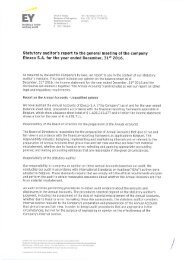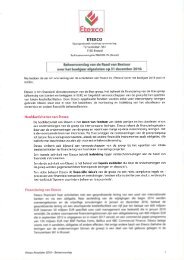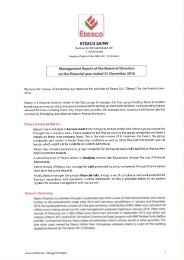ETX-10829_Etex-AR2017_WEB_2018_DEF2 (2)
You also want an ePaper? Increase the reach of your titles
YUMPU automatically turns print PDFs into web optimized ePapers that Google loves.
6.1<br />
Financial report<br />
Consolidated financial statements<br />
<strong>Etex</strong> Annual Report 2017<br />
Financial report<br />
Consolidated financial statements<br />
C - Use of judgement, estimates and assumptions<br />
The preparation of financial statements in conformity with IFRS requires management to make judgements, estimates and assumptions<br />
that affect the reported amounts of revenue, expenses, assets, liabilities and related disclosures at the date of the financial statements.<br />
These judgements, estimates and associated assumptions are based on management’s best knowledge at reporting date of current<br />
events and actions that the Group may undertake in the future. However, actual results could differ from those estimates, and could<br />
require adjustments to the carrying amount of the asset or liability affected in the future. The estimates and underlying assumptions are<br />
reviewed on an ongoing basis.<br />
The significant estimates made by management concerning the future and other key sources of estimation uncertainty at the balance<br />
sheet date that have a significant risk of causing a material adjustment to the carrying amount of assets and liabilities within the next<br />
financial year are discussed below.<br />
Impairment of non-financial assets<br />
The recoverable amount of the cash-generating units tested for impairment is the higher of its fair value less costs to sell and its value in<br />
use. Both calculations are based on a discounted cash-flow model. The cash flows are derived from the budget for the next three to ten<br />
years. The recoverable amount is most sensitive to the discount rate used for the discounted cash flow model as well as the expected<br />
future cash inflows and the growth rate used for extrapolation purposes. The key assumptions used to determine the recoverable amount<br />
for the different cash-generating units, including a sensitivity analysis, are further explained in Note 8.<br />
Provisions<br />
The assumptions that have significant influence on the amount of the provisions are the estimated costs, the timing of the cash outflows<br />
and the discount rate. These assumptions are determined based on the most appropriate available information at reporting date. Further<br />
details about the assumptions used are given in Note 19.<br />
Employee benefits<br />
The measurement of the employee benefits is based on actuarial assumptions. Management believes that the assumptions about<br />
discount rates, expected rates of return on assets, future salary increases, mortality rates and future pension increases used for these<br />
actuarial valuations are appropriate and justified. They are reviewed at each balance-sheet date. However, given the long-term nature of<br />
these benefits, any change in certain of these assumptions could have a significant impact on the measurement of the related<br />
obligations. Further details about assumptions used are given in Note 21.<br />
Recognition of deferred tax assets on tax losses carried forward<br />
Deferred tax assets are recognised for all unused tax losses to the extent that it is probable that taxable profit will be available against<br />
which the losses can be utilised. Significant management judgment is required to determine the amount of the deferred tax assets that<br />
can be recognised, based upon the likely timing and the level of future taxable profits together with future tax planning strategies. The<br />
potential utilisation of tax losses carried forward is based on budgets and forecasts existing at reporting date. Actual results could differ<br />
from these budgets with an impact on the utilisation of tax losses carried forward.<br />
Cash-settled share-based payment transaction<br />
The Group measures the cost of cash-settled transactions with employees by reference to the fair value of the equity instruments at each<br />
reporting date. Estimating fair value for share-based payment transactions requires determining the most appropriate valuation model,<br />
which is dependent on the terms and conditions of the grant. This estimate also requires determining the most appropriate inputs to the<br />
valuation model including the expected life of the share option, volatility and dividend yield and making assumptions about them. The<br />
assumptions and model used for estimating fair value for share-based payment transactions are disclosed in Note 22.<br />
Financial instruments<br />
To measure the fair value of financial assets that cannot be derived from active markets, management uses a valuation technique based<br />
on discounted future expected cash flows. The inputs of this model require determining a certain number of assumptions, including<br />
discount rate, liquidity risk and volatility, subject to uncertainty. Changes in these assumptions could have an impact on the measurement<br />
of the fair value. Further details are given in Note 16.<br />
D - Basis of consolidation<br />
Subsidiaries<br />
Subsidiaries are entities that are controlled, directly or indirectly, by the Company.<br />
Control is achieved when the Group is exposed, or has rights, to variable returns from its involvement with the investee and has the<br />
ability to affect those returns through its power over the investee. Specifically, the Group controls an investee if, and only if, the Group<br />
has:<br />
−<br />
−<br />
−<br />
Power over the investee (i.e., existing rights that give it the current ability to direct the relevant activities of the investee)<br />
Exposure, or rights, to variable returns from its involvement with the investee<br />
The ability to use its power over the investee to affect its returns<br />
Generally, there is a presumption that a majority of voting rights result in control. To support this presumption and when the Group has<br />
less than a majority of the voting or similar rights of an investee, the Group considers all relevant facts and circumstances in assessing<br />
whether it has power over an investee, including:<br />
−<br />
−<br />
−<br />
The contractual arrangement with the other vote holders of the investee<br />
Rights arising from other contractual arrangements<br />
The Group’s voting rights and potential voting rights<br />
The Group re-assesses whether or not it controls an investee if facts and circumstances indicate that there are changes to one or more of<br />
the three elements of control. Consolidation of a subsidiary begins when the Group obtains control over the subsidiary and ceases when<br />
the Group loses control of the subsidiary. Assets, liabilities, income and expenses of a subsidiary acquired or disposed of during the year<br />
are included in the consolidated financial statements from the date the Group gains control until the date the Group ceases to control the<br />
subsidiary.<br />
Profit or loss and each component of other comprehensive income (OCI) are attributed to the equity holders of the parent of the Group<br />
and to the non-controlling interests, even if this results in the non-controlling interests having a deficit balance.<br />
When necessary, adjustments are made to the financial statements of subsidiaries to bring their accounting policies into line with the<br />
Group’s accounting policies. All intra-group assets and liabilities, equity, income, expenses and cash flows relating to transactions<br />
between members of the Group are eliminated in full on consolidation.<br />
A change in the ownership interest of a subsidiary, without a loss of control, is accounted for as an equity transaction.<br />
If the Group loses control over a subsidiary, it derecognises the related assets (including goodwill), liabilities, non-controlling interest and<br />
other components of equity while any resultant gain or loss is recognised in profit or loss. Any investment retained is recognised at fair<br />
value.<br />
Investments in associates and joint ventures<br />
A joint venture is a type of joint arrangement whereby the parties that have joint control of the arrangement have rights to the net assets<br />
of the joint venture. Joint control is the contractually agreed sharing of control of an arrangement, which exists only when decisions about<br />
the relevant activities require unanimous consent of the parties sharing control. Equity accounted investees are companies over which<br />
the Group generally holds between 20 per cent and 50 per cent of the voting rights. The Group’s interest in joint ventures or equity<br />
accounted investees is consolidated using the equity method.<br />
Equity accounting starts when joint control or significant influence is established until the date it ceases. When the Group’s share of<br />
losses exceeds its interest in an equity accounted investee, the carrying amount is reduced to nil and recognition of any further losses is<br />
discontinued, except to the extent that the Group has an obligation or has made payments on behalf of the investees. The financial<br />
statements of these companies are prepared for the same reporting year as the Company, using consistent accounting policies.<br />
Adjustments are made to bring into line any dissimilar accounting policies that may exist. Unrealised gains arising from transactions with<br />
joint ventures and equity accounted investees are eliminated to the extent of the Group’s interest. Unrealised losses are eliminated the<br />
same way as unrealised gain but only to the extent that there is no evidence of impairment. The investments accounted for using the<br />
equity method include the carrying amount of any related goodwill.<br />
<strong>Etex</strong> Annual Report 2017 p. 7<br />
<strong>Etex</strong> Annual Report 2017 p. 8<br />
102 103
















